What industries benefit most from versatile custom metal bending solutions?
Introduction
Versatile custom metal bending enables manufacturers to form complex geometries with high repeatability, allowing for the efficient production of structural, functional, and aesthetic components. As an engineer working across multi-process fabrication chains, I observe that industries requiring lightweight structures, high-strength frames, and precise enclosures gain the most value from flexible bending technologies.
Industries That Rely Heavily on Custom Metal Bending
Aerospace
The aerospace industry requires lightweight, high-strength components that can withstand extreme loads and temperature variations. Custom bending supports brackets, heat shields, support frames, and thin-wall structures. Precision cutting methods, such as laser cutting and metal forming through bending, enable aerospace engineers to meet stringent dimensional requirements while minimizing material waste.
Automotive
In the automotive sector, bent metal parts are used to form chassis reinforcements, EV battery enclosures, interior brackets, crash-energy structures, and exhaust components. Workflow integration with sheet metal fabrication and high-volume operations like sheet metal stamping ensures cost-effective mass production with consistent bend geometry.
Consumer Electronics
Manufacturers in consumer electronics utilize bending for thin housings, EMI shielding frames, internal mounting plates, and heat-spreading components. Clean, oxidation-free pre-processing with laser cutting and fast prototyping via prototyping benefit small and intricate geometries common in phones, laptops, and smart devices.
High-Performance Materials Supporting Industry Needs
Versatile bending accommodates a wide range of alloys depending on industry specifications. Stainless materials, such as cast stainless steel, are valued for their structural stability. Aluminum-based materials, including cast aluminum and high-flow die-casting grades like A380, offer excellent forming behavior for lightweight components. Specialty metals, such as nickel-based alloys, support aerospace and energy applications, while conductive metals, like copper alloys, enable the production of precise bent terminals, shields, and connectors. Lightweight alloys, such as magnesium alloys, further reduce mass for automotive and electronic structures.
Supporting Processes That Strengthen Industry Outputs
Manufacturing workflows that precede or follow bending have a significant influence on the final quality. Accurate pre-cut blanks generated by laser cutting ensure predictable forming. Early design validation through CNC machining prototyping allows industries to test tolerances before mass production. For parts originating from casting operations, routes such as investment casting deliver bend-ready blanks.
Surface finishing also contributes to long-term performance. Protective coatings, such as powder coating, enhance corrosion resistance, while thermal strengthening through heat treatment ensures mechanical stability after bending.
Conclusion
Industries with high-performance, structural precision, and lightweight design requirements rely most heavily on custom metal bending—especially aerospace, automotive, and consumer electronics. The ability to work across many materials, integrate with advanced cutting and casting workflows, and adopt tailored finishing methods makes bending a key contributor to manufacturing efficiency and product reliability.



